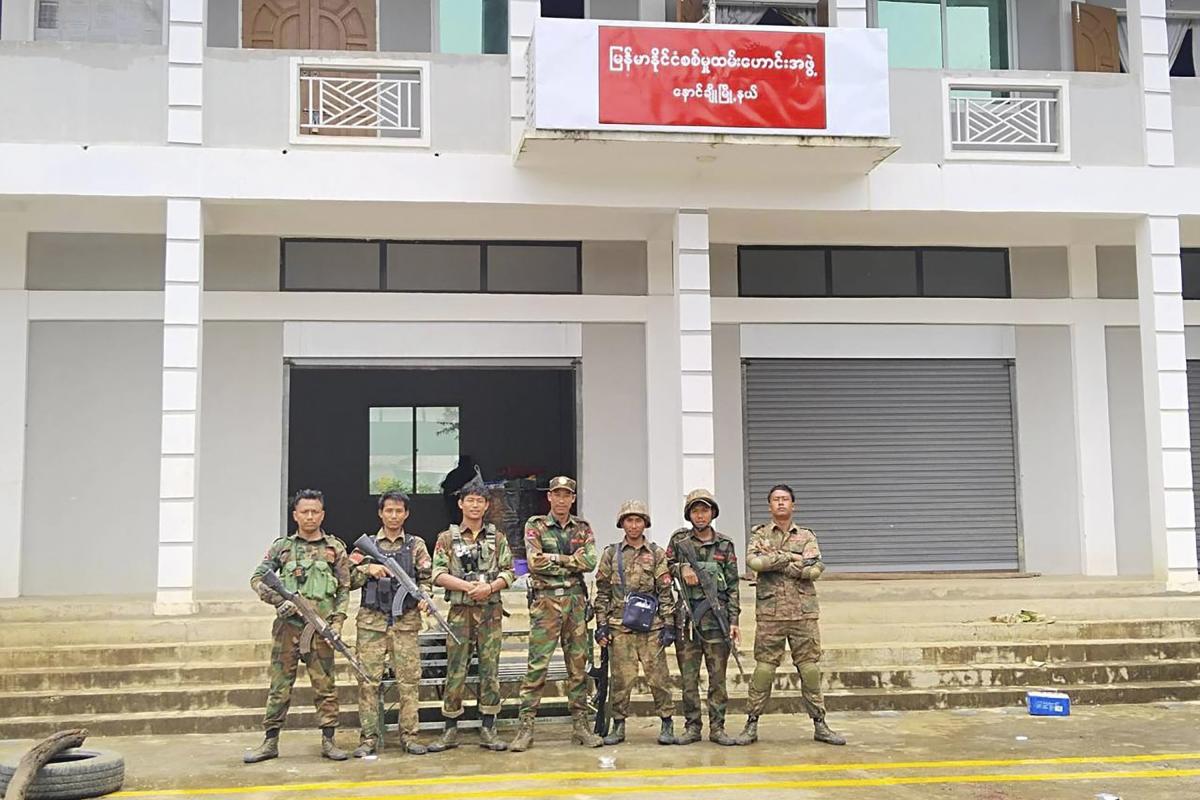BANGKOK (AP) — Fresh fighting has broken out in northeastern Myanmar, ending a China-brokered cease-fire and putting pressure on the military regime as it faces attacks from resistance groups on multiple fronts in the country’s civil war.
The Ta’ang National Liberation Army, one of three powerful militias that launched a surprise joint offensive last October, last week resumed attacks on regime positions in northeastern Shan State, which borders China, Laos and Thailand, and the adjacent Mandalay region, with the support of local forces there.
Since then, the Myanmar National Democratic Alliance military has joined in, and on Friday joint forces from the two allied militias reportedly surrounded the strategically important town of Lashio, headquarters of the regime’s northeastern military command.
This is the next phase of the October “1027” offensive, said Lway Yay Oo, spokesman for the TNLA, who said last week that the army was provoking retaliation with artillery and air strikes despite the ceasefire.
“In phase two, our main goal is to eradicate the military dictatorship, and number two is the protection and security of the local population,” she said.
Thet Swe, a spokesman for the military regime that seized power from the elected government of Aung San Suu Kyi in February 2021, accused the militias of endangering civilians by restarting the fighting.
“As the TNLA begins to violate the ceasefire, the Tatmadaw is protecting the lives and property of the ethnic population,” he said in an email to AP, referring to the army by its Burmese name.
There was no indication that the third ethnic armed group that forms the Three Brotherhood Alliance, the powerful Arakan Army, had joined the renewed fighting in Shan State. However, the army’s troops never stopped fighting in its home state of Rakhine, which was not covered by the January 11 ceasefire.
The TNLA claims to have captured more than 30 military posts and now controls the western part of Mogok, whose ruby mines make it a lucrative target. Fighting is also taking place over the town of Kyaukme, which lies at a crossroads of highways, and Nawnghkio to the southwest, which leads to the large military garrison town of Pyin Oo Lwin along the same highway.
“That’s where you have to cut the connection to prevent the military from sending reinforcements,” said Morgan Michaels, a Singapore-based analyst at the International Institute of Strategic Studies who leads the Myanmar Conflict Map project.
In Mandalay, the region to the west of Shan, a local People’s Defense Force joined the TNLA offensive. It is one of many armed resistance groups formed in support of the underground National Unity Government, which sees itself as the legitimate government of Myanmar.
Osmond, a spokesman for the Mandalay People’s Defense Force who would only give his alias because of security concerns, said his and other local resistance groups had captured nearly 20 military outposts.
The Three Brotherhoods’ October offensive was swift, with the militias capturing large areas in the north and northeast, including several key border crossings with China and several large military bases.
The alliance’s militias have close ties to China and the offensive is widely believed to have had Beijing’s tacit approval, amid growing dissatisfaction with the military regime’s apparent indifference to the growing drug trade along the border and the proliferation of cyber fraud hubs in Myanmar, where workers are smuggled from China and elsewhere in the region.
China subsequently helped broker a ceasefire in January, ending major fighting in the northeast. Meanwhile, other ethnic armed organizations and PDF groups launched their own attacks on regime positions elsewhere in the country.
With renewed violence in the northeast, China’s Foreign Ministry told AP it was ready to renew its support for peace talks, but declined to say whether it had had direct contact with the Three Brotherhoods or the military-backed State Administrative Council.
“China urges all parties in Myanmar to strictly abide by the ceasefire agreement, exercise maximum restraint, withdraw as soon as possible, and take practical and effective measures to ensure the calm along the China-Myanmar border and the safety of Chinese personnel and projects,” the ministry said in a faxed response to questions.
According to Michaels, the Myanmar military does not appear to be surprised by the TNLA attacks. There are indications that the military has mobilized troops and prepared defenses, security checkpoints and patrols in advance of the renewed offensive.
“They are not completely surprised, although they have not yet been able to react. There has also been no counteroffensive,” he said.
It is not yet clear what the TNLA’s objectives are. It may be that the group simply wants to make gains and consolidate positions, while the army is already busy fighting on several fronts, and before new batches of conscripts are trained for service.
Already 5,000 conscripts have been added to the army’s ranks, with another 10,000 expected before the end of the year. Thet Swe said they would not be sent into battle but would instead be used as sentries and other such duties, freeing up better-trained soldiers for the front lines.
“If the draft continues and the military can stop these violations and hold out through the end of the year, there could be a counteroffensive next year,” Michaels said. “So this is the last window to get this done.”
It is also unclear whether the MNDAA plans to join the broader offensive or whether it intends to take the encircled Lashio by force, besiege it or simply tie down the troops currently trapped there. The group did not respond to requests for comment.
“If you compare it to 1027 the first time, it’s not the same rapid collapse of the military,” Michaels said.
“The military is still suffering losses, but it’s just not the same scale or pace. But if the MNDAA fully joins in, then we’re looking at a different situation.”







